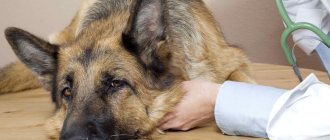Some dogs are also “talkers”. They love to bark, whine, and whine, begging for treats from their owner. This constant “chat” can not only amuse or irritate the owner. If your dog is hoarse, there is a chance that it is due to over-irritation of the tissues in the larynx . However, there are other predisposing factors. Some of them can pose a serious danger to both the health and life of your pet. Let's look at the most common of them.
Laryngitis
This is the name for inflammation of the tissues of the larynx. Dogs can get it just like people. The result is either hoarseness or a complete loss of the ability to reproduce at least some sounds. At the same time, the dog can only “squeak” or wheeze. There are many reasons that contribute to irritation and subsequent inflammation of the laryngeal tissues.
If your dog looks like a frog, silently opening and closing its mouth, but there are no other signs of something wrong, you can relax: most likely, the inflammation arose due to overstrain of the larynx (when the pet likes to bark, there is nothing surprising in this). In mild cases, all problems disappear spontaneously within a couple of days. Unfortunately, this doesn't happen often.
In many cases, laryngitis is a disease of inflammatory etiology, resulting from the action of pathogenic or conditionally pathogenic microflora. The most common cause is hypothermia, hypothermia. A fairly common problem for dogs that constantly live on the street.
Diagnosis of the disease
After the animal is taken to the doctor, he will carefully examine it and palpate the submandibular lymph nodes and neck. Then the dog's lungs and heart will be listened to for changes in its tones. If such procedures do not provide an accurate understanding of the cause of muteness, then the use of modern anesthesia techniques such as sedation is acceptable. With its help, you can examine the dog’s pharynx as painlessly as possible in order to exclude the influence of factors such as an abscess, paresis of the glottis or the presence of foreign objects inside the larynx on the lack of voice.
Diagnostics also includes bronchoscopy and collection of blood fluid for general analysis. The latter measure will detect hypothyroidism, which changes the amount of thyroid hormones in the dog's blood.
Hoarseness of infectious etiology
In addition to laryngitis, hoarseness can be caused by other diseases of an inflammatory nature (infectious and non-infectious etiology). In particular, bronchitis is widespread, and in severe cases there is a high risk of developing pneumonia. It is quite easy to guess the severity of the disease - the animal becomes inactive, its general body temperature rises (intermittent fever is also possible), the pet experiences severe weakness, refuses food, but its thirst does not suffer. The dog cannot bark, a frequent and prolonged cough appears, gurgling and wheezing are clearly audible in his chest.
Note that infectious pneumonia can be a secondary disease, the development of which leads to some forms of helminthiasis. The problem is that the larvae of worms at the first stage of their development must get into the lungs (through the bloodstream). Of course, this does not improve the health of the organ; the likelihood of developing a secondary infection increases sharply. Which, in fact, often happens when a dog’s voice becomes hoarse.
What is the best anti-barking device?
Best Anti-Bark Devices for 2022
- SportDOG NoBark SBC-R Rechargeable Bark Control Dog Collar - Best Overall.
- PetSafe Spray Shield is a runner up.
- Petrainer 998DRB Remote Dog Training Collar - Best Budget.
- The PetSafe Static Basic Bark Control Collar is the BEST EASY.
THIS IS INTERESTING: Frequently asked question: How much does a dog’s stomach cost?
17.06.2019
Other predisposing factors
Are there other causes of hoarseness? Yes, quite a lot. If we started talking about problems with the trachea, we need to note two more: its mechanical injuries and airway obstruction . With injuries, everything is clear - if the throat was damaged as a result of some strong impact, this could lead to a violation of the integrity of the trachea. Obstruction is a phenomenon in which the trachea is compressed or pinched by something. Very often this “something” is a tumor. Its etiology does not matter - a benign neoplasm in this case is no less dangerous than cancer.
Sometimes foreign bodies, including parasites and pieces of food, can enter the trachea, causing the animal to develop a severe cough. Because of this, the tissues of the larynx and trachea become severely irritated, resulting in hoarseness.
How to help a dog with voice loss
So, self-medication based on the recommendations of neighbors and friends is not the best option for solving the problem. Since it is necessary to start by clarifying the circumstances of the pathology. Watch your dog. You may see other signs of trouble that need to be reported to your veterinarian. Before visiting the veterinary clinic and prescribing a course of therapy for your pet, you can do something yourself. For example, ventilate the room more often if the dog is in it, monitor the cleanliness of the water in the animal’s drinking bowl, and change it more often.
Try examining your dog or puppy's larynx yourself. This must be done carefully, in a playful manner, without causing pain to the pet. Perhaps you will need an assistant for this. But don't overdo it! If you manage to find any inflammation or mechanical damage, then to avoid further injury to the tissues of the pharynx, try to fix the dog in an ergonomic position and demonstrate to the doctor.
Sometimes antihistamines, for example, Claritin, Tavegil, Suprastin, help with swelling of the throat. They should be given to the dog depending on its weight.
If the cause of the trouble is a cold, then you need to treat it specifically, and your voice will gradually return to normal.
Only a doctor can remove a bone or polypoid formations stuck in the throat.
Treatment options
So what should you do if your dog suddenly becomes hoarse? It is necessary to take him to the veterinarian as soon as possible. It is possible that your pet does not have any serious illnesses, but it is still better to be safe. Treatment methods directly depend on the root cause. Thus, foreign bodies from the airways are removed surgically, and tumors that cause obstruction are also removed. If helminths are present, they are destroyed using specialized drugs. Important note - most drugs against larvae are not effective, and therefore the treatment is repeated after about two weeks (at this time small parasites are already in the intestines).
Rehabilitation period
A necessary condition for the dog's recovery is high-quality postoperative care. The owner must show maximum sensitivity and surround the four-legged pet with love and affection.
On the first day, the dog receives food in warm liquid form. Giving dry food is prohibited, as is chewing chew toys. The animal should not move, play, jump, run, or communicate with other animals.
To avoid swelling and respiratory distress syndrome in the throat, you need to monitor your breathing and general well-being. If complications develop, it becomes necessary to cut the larynx (emergency tracheostomy) so that the dog can breathe.
What is it for
The first reason the Ancient Romans docked dogs' tails was for safety. The smaller the body area of a fighting dog, the more difficult it is to inflict wounds during a fight. So not only the tails of the gladiator dogs were cut, but also the ears.
Peasants in the Middle Ages performed docking on herding dogs. People believed that this procedure would protect against rabies. A little later, in the 18th century, in England, bushy tails were cut for shepherd dogs guarding herds. The shepherds believed that this would make it easier for the dogs to fight the wolves. In addition, they did not want to deal with hygiene procedures, pulling out garbage and branches from the wool.
Hunting dogs had their tails cut off to prevent them from clinging to trees and bushes while chasing wild animals. The procedure was especially useful for burrow hunters who encountered a predator underground in complete darkness.
But it wasn’t just the reasons for preserving the pet’s health that worried the breeders. Since the 18th century, there was a law in Europe according to which a tax was charged for any purebred non-working dog. A docked tail was a sign that the dog belonged to a police or security unit.
Now almost all of Europe has banned the amputation of tails for cosmetic purposes. The law allows circumcision only for service dogs that are registered with police, border, and rescue services.
In the CIS countries the situation is different; docking is still considered legal if required by the breed standard. The final decision still remains with the owner.
"Non-barking" breeds
The world of dog breeds is rich and diverse. There are breeds that “can’t” bark in principle, they only make various (sometimes quite funny) sounds. Other “quiet” breeds are well aware of what barking is, but they voice extremely rarely and reluctantly. By the way, scientists are still at a loss as to why some breeds (for example, Basenji) never “learned” to bark. But we wouldn’t consider Basenjis to be completely quiet – their vocal arsenal is quite rich. They howl and whine and make other unusual sounds that we cannot even accurately characterize. It’s better, as they say, to listen once. We also recommend that you read our publications on ilike.pet: here are links to the first and second articles on the topic.
Physiological symptoms
It often happens that with the help of vomiting, a pet tries to remove food or an object from the body that got inside by accident, by mistake, a kind of one-time irritant. It cannot be said that when such cases arise, the owner only needs understanding and care - one should carefully analyze the care of the pet and take the necessary measures to eliminate the disease.
List of possible causes of nausea:
- Stressful situations. Strong emotions - joy, sadness, excitement - can be the causes of food incontinence. It is important to calm the dog down and avoid repeating these moments.
- Difficult to digest food. Abuse of foods that are “heavy” for a pet causes unpleasant consequences in the form of constipation, bloating, and stomach emptying.
- Worms. A common complication among four-legged pets. If you suspect the presence of worms, it is better to consult a veterinarian.
- Food allergies.
Pathological symptoms
Vomiting may be a signal of an ingrained problem in the pet’s body, closely related to gastrointestinal or systemic diseases:
- Encephalitis, brain tumors, meningitis, and other diseases, the consequences of which are the destruction of the central nervous system.
- Inflammation of the small and large intestines (enteritis, colitis).
- Ulcer, gastritis, pancreatitis.
- Obstruction of the gastrointestinal tract.
- Damage to the liver, kidneys, inflammation of the peritoneum.
The importance of training
It was not for nothing that we started the article with problems arising due to random barking.
Some owners unwittingly encourage such behavior patterns themselves, and then do not know how to get rid of them. According to experts, the role of training is quite large: in principle, any dog can be trained to vocalize only on command. The general advice is: never encourage behavior patterns that you don't want. Dogs constantly look back at their owners, constantly checking their watches with them. Seeing that certain of their actions do not receive rewards, they abandon these actions. However, a dog is a dog. As many fellow authors argue, you shouldn’t stop a dog from being a dog. Once you notice that your pet’s vocal abilities have noticeably failed, there is no need to delay a visit to the veterinarian.
Original: Why Doesn't My Dog Bark? Source: pets4homes.co.uk Photo: pixabay.com











